1 of 70
Download to read offline

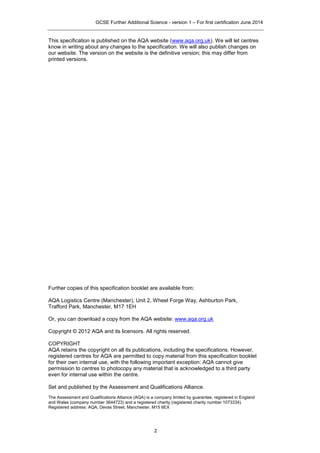
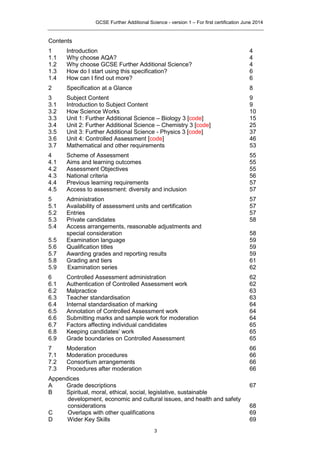
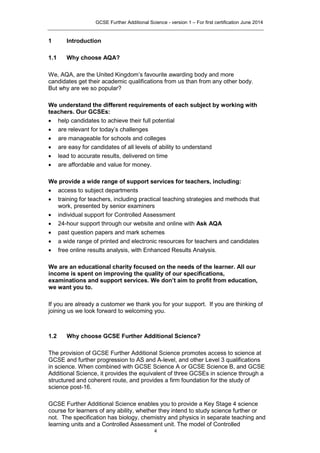
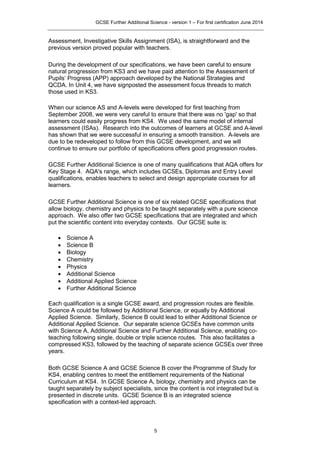
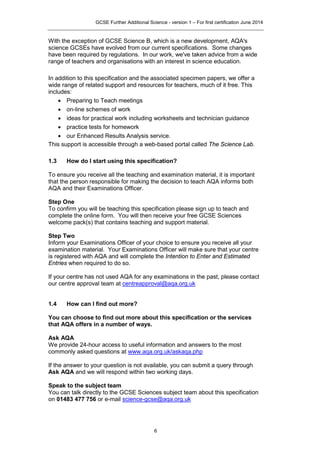




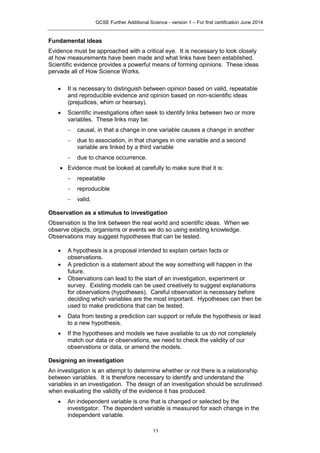
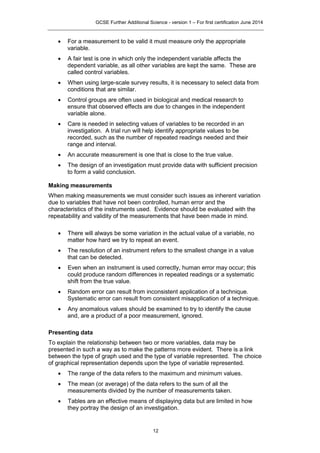


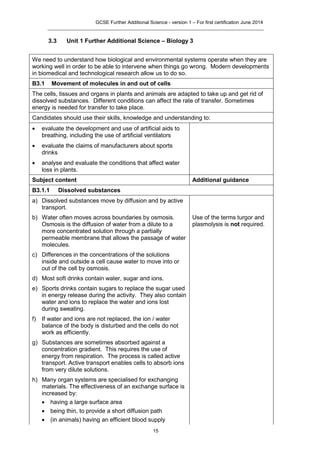
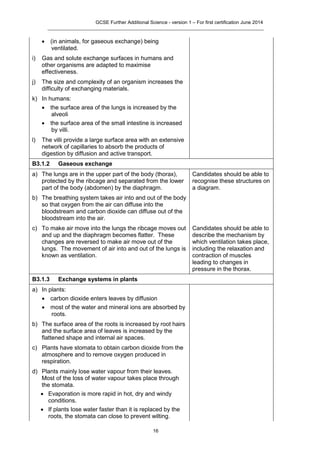
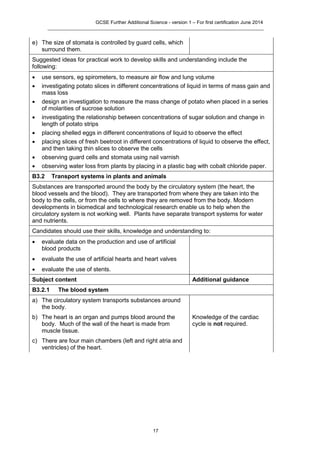



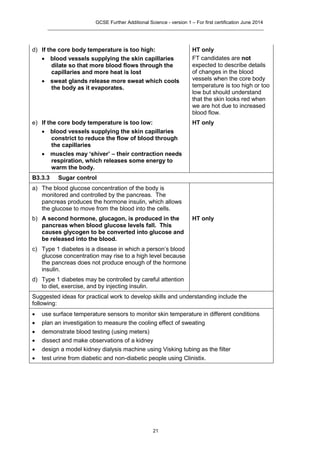
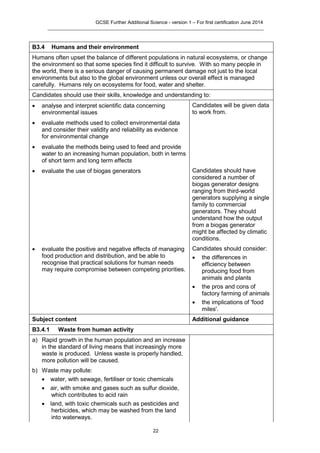
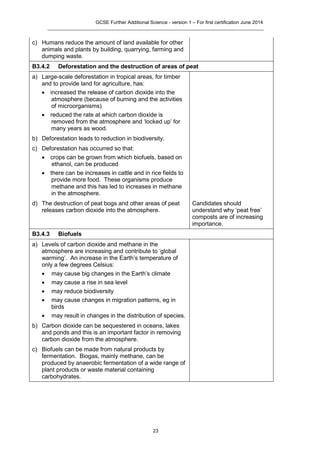
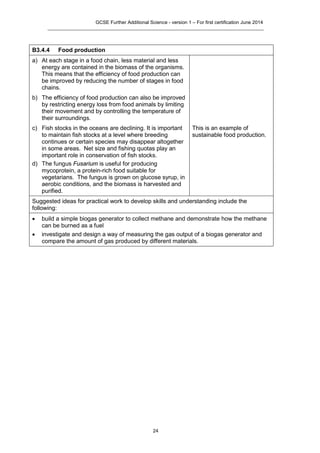
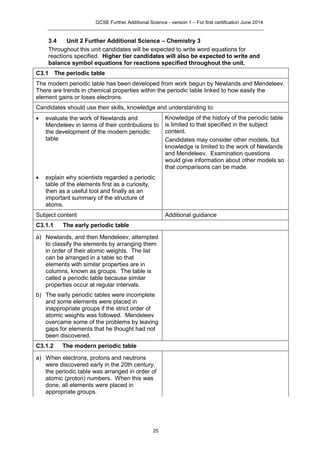
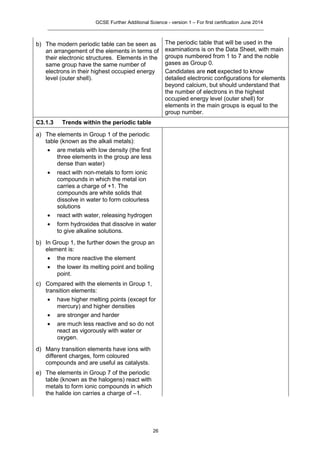
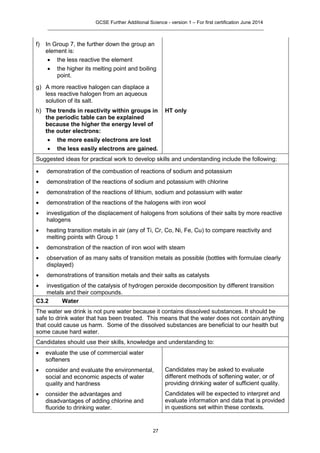

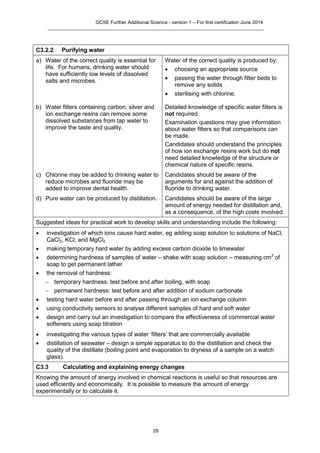

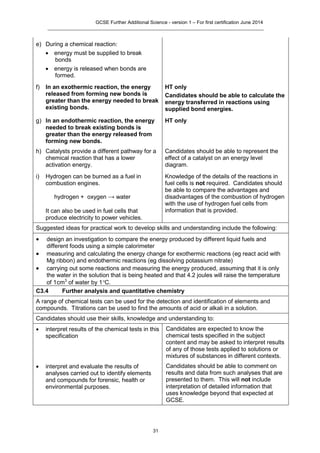
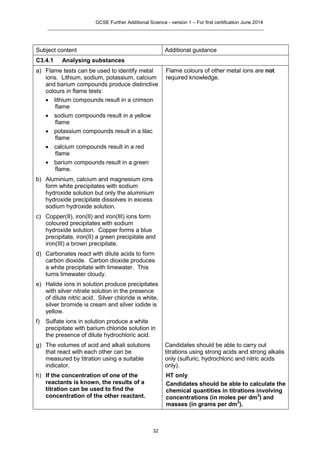

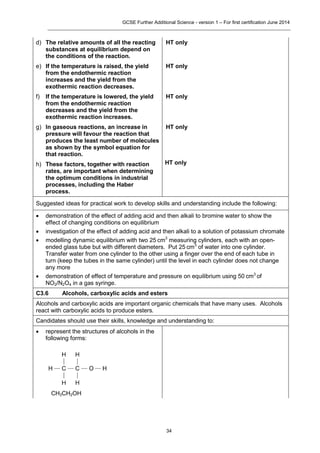
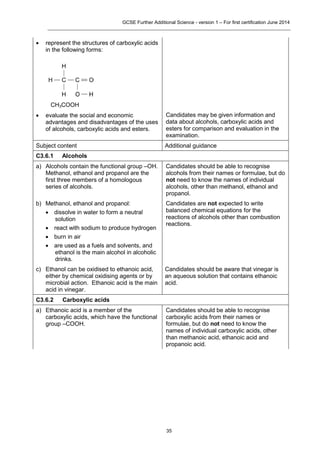
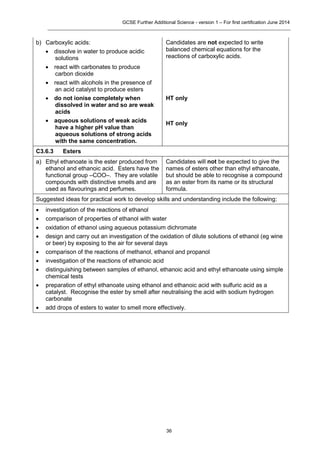
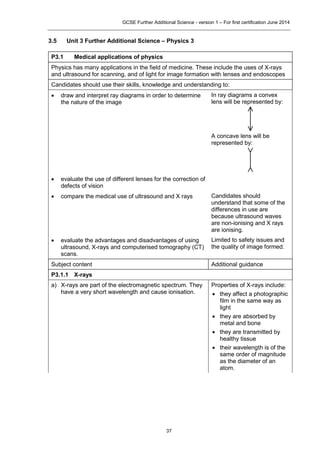
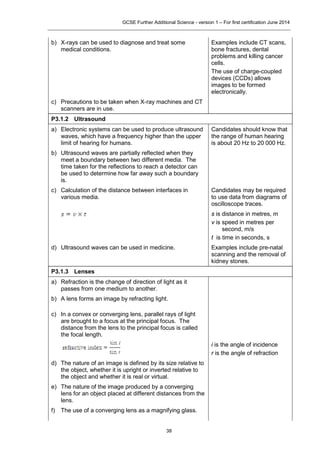
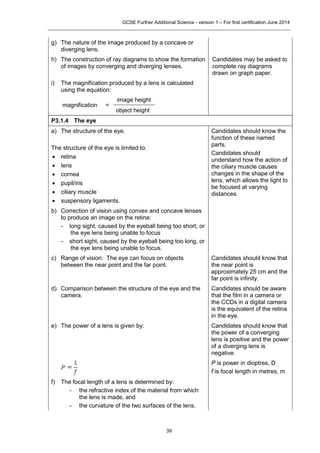
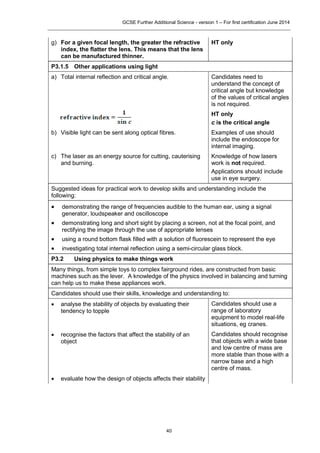

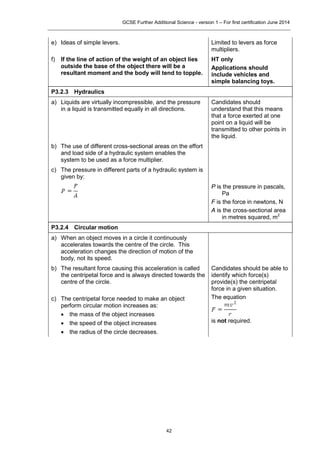
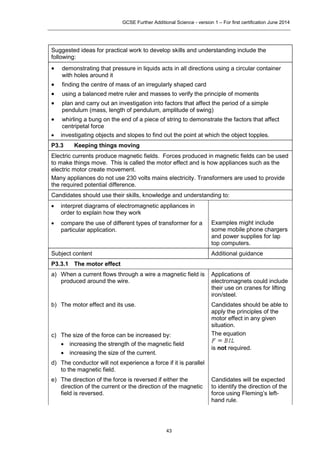
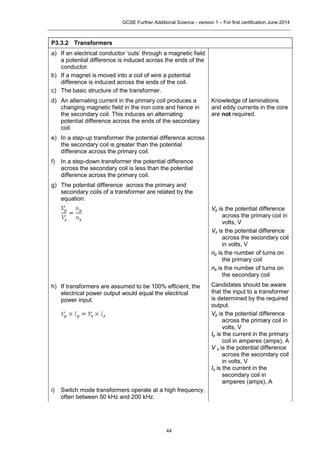
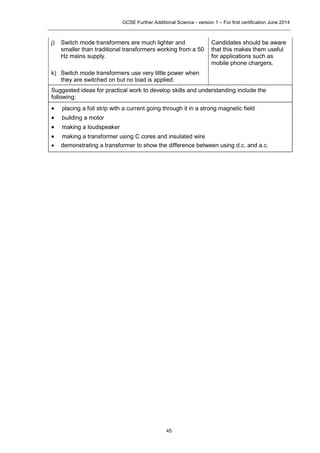


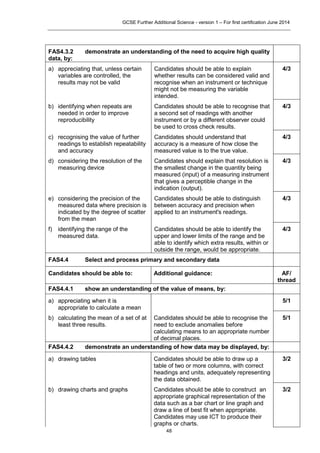
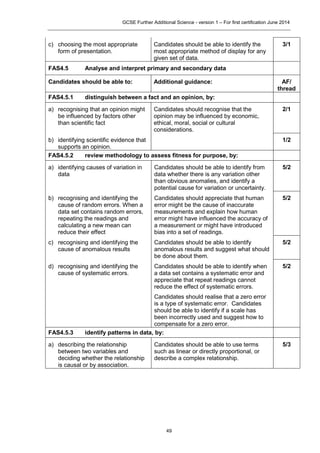
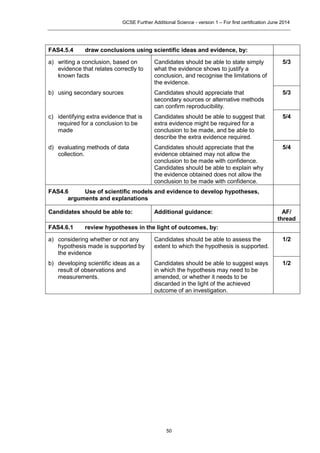


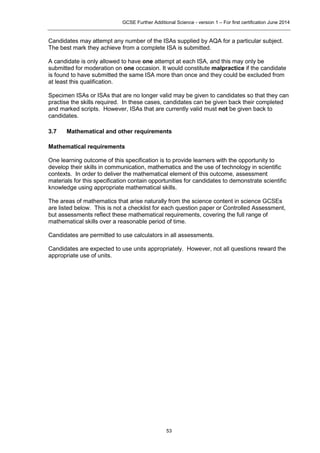

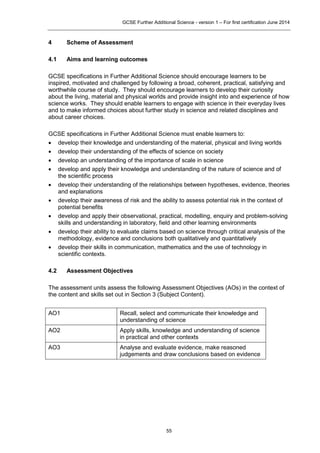
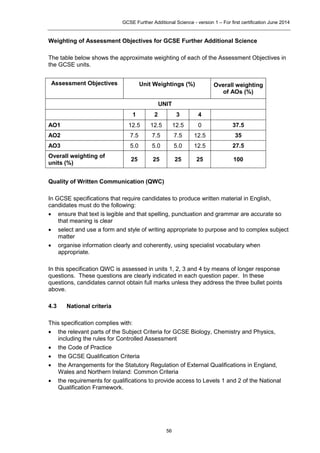
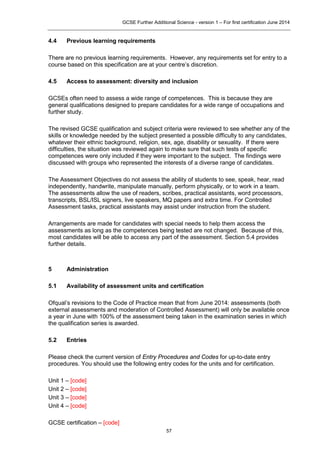
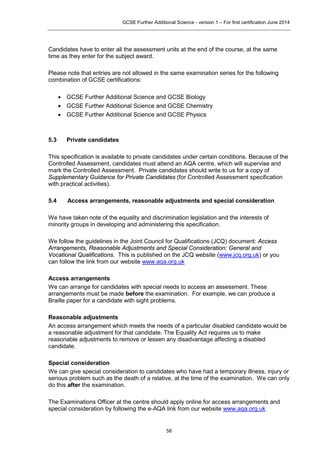
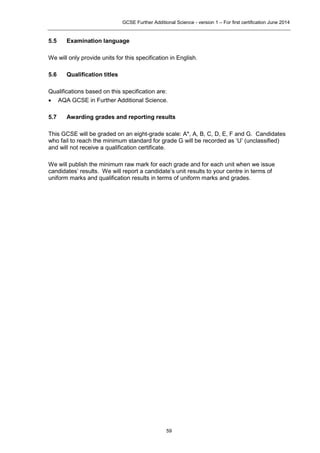




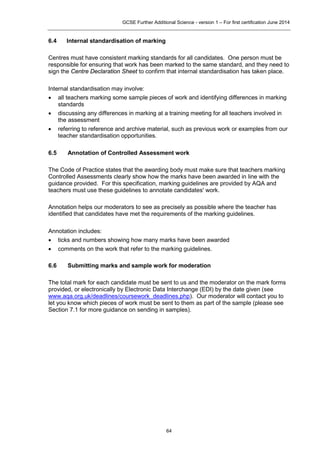
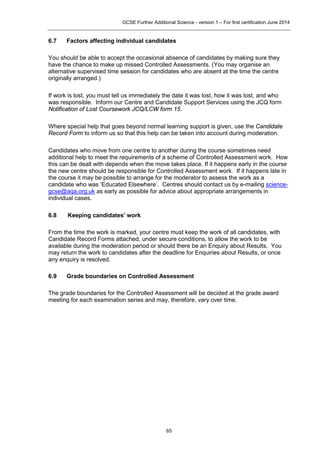
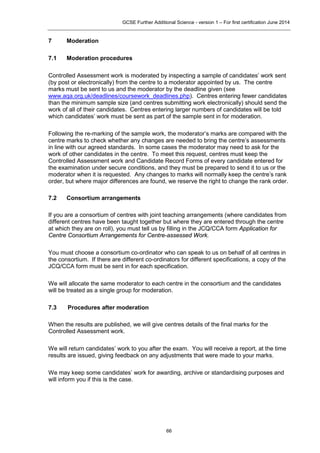
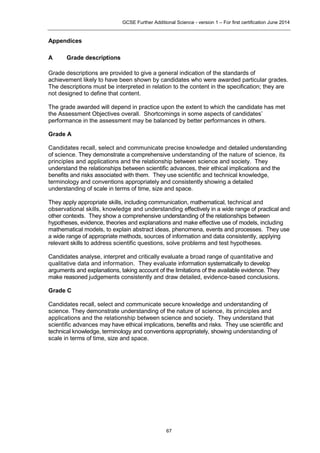
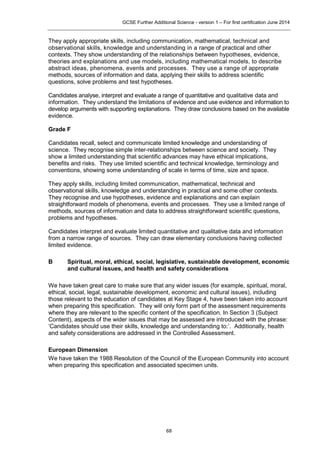
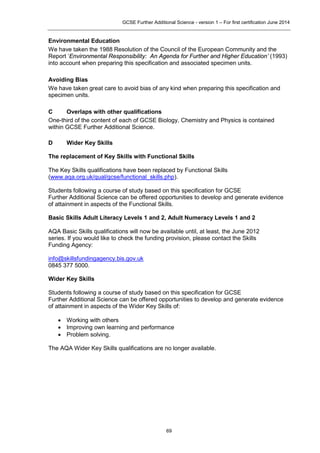
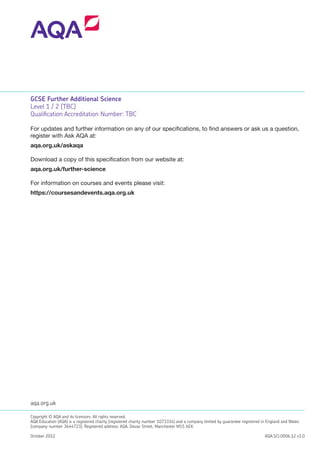
Ad
Recommended
Gcse sci-h-b1
Gcse sci-h-b1opsonise
╠²
Here are the key points about controlled assessment:
- It makes up 25% of the total GCSE grade.
- Students complete practical experiments and investigations over a period of about 9 hours.
- The experiments are set by the exam board and relate to the modules studied in class.
- Students plan investigations, collect and analyse data, evaluate methods and draw conclusions.
- Teachers mark the work but it is moderated by the exam board to ensure fairness.
- The skills assessed include experiment design, data collection and analysis, evaluation and written communication.
- It allows students to demonstrate practical and investigative skills that can't be assessed in written exams.
- The work is submitted to the examY8 Electricity 02 current electricity
Y8 Electricity 02 current electricityMs Yam
╠²
The document discusses modeling electric circuits and current flow. It explains how to represent current as the flow of charge through a circuit using models like moped riders carrying pizzas. It also describes using a water circuit model and electrical circuit symbols. Students are asked to design their own circuit with a switch and draw it using the proper symbols. An exit ticket asks students to list things they want to practice, expect on a test, and enjoyed from the lesson.7.2 relationship between electric current and potential difference
7.2 relationship between electric current and potential differenceAdlishah Risal Bili
╠²
Chapter 7 discusses the relationship between electric current and potential difference, explaining potential difference as the work done per unit charge between two points in a circuit. It outlines Ohm's Law, which states that the current is directly proportional to potential difference in ohmic conductors, and highlights the roles of resistance and superconductivity in electrical systems. The document also explores the advantages of superconductors in technology, such as in maglev trains and MRI scanners.Research Project Report
Research Project ReportJoan Cahuich Perez
╠²
The document discusses the author's research project which aims to study the effect of PLEs (personal learning environments) on vocabulary acquisition among international relations students with a basic English level. The author spoke with their partner Astrid about focusing on this student group since they need to learn more vocabulary. They also discussed using theories like connectivism, constructivism and LaaN theory to support the research, as well as a book on invisible learning that considers technological advances in education.Edgemont in ph
Edgemont in phPark Hill Neighborhood Association
╠²
This document provides historical context for the development of Edgemont in Park Hill, a subdivision of North Little Rock, Arkansas from 1927-1931. It describes how developer Justin Matthews created Edgemont to compete with upscale neighborhoods in Pulaski Heights by featuring larger, more expensive homes on curving streets with scenic views. Matthews planned Edgemont to attract upper-middle and upper-class residents through deed restrictions and neighborhood amenities like paved streets and utilities.Logistics: The Missing Link in Blend Scheduling Optimization
Logistics: The Missing Link in Blend Scheduling OptimizationAlkis Vazacopoulos
╠²
This document discusses logistics scheduling optimization for blending liquids. It begins by introducing blending and describing logistics scheduling as the "coarse-tune" that determines quantity and logic details, while quality scheduling performs the "fine-tune." It then provides examples of key logistics constraints like minimum/maximum run lengths. The document emphasizes that ignoring logistics leads to suboptimal schedules. It proposes various metrics to quantify non-compliance with logistics constraints. Finally, it presents a framework to trade off quantity and quality using "logistics isotherms" and argues explicit logistics scheduling can improve this trade-off relationship.IMPL Data Analysis
IMPL Data AnalysisAlkis Vazacopoulos
╠²
This document outlines three data analysis techniques ŌĆö checking, clustering, and componentizing ŌĆö utilized by Industrial Gorihm LLC for real-time decision-making applications. It details data checking routines that ensure data integrity, fuzzy c-mean clustering for identifying process modes, and principal components analysis for dimensionality reduction in data. Additionally, a new approach called principal component regression optimization (PCRO) is introduced to enhance the efficiency of regression analysis compared to traditional methods.Fin 630 u1 ip
Fin 630 u1 ipDeveye Hademeon
╠²
The document discusses the international expansion plans of Acme Manufacturing Company into either Germany or South Africa. It analyzes the advantages and disadvantages of creating a new manufacturing facility, or "Greenfield," in each country. While Germany provides economic strengths and access to the EU market, operating costs are higher and the Euro's value is uncertain. South Africa offers lower costs and access to the African market, but risks include currency instability and some social and regulatory challenges. Ultimately, the document recommends expanding to South Africa due to its growth potential, natural resources, and ability to reach hundreds of millions of African consumers.ą¤č¢ą┤čüčāą╝ą║ąĖ ą╝č¢čüčīą║ąŠą│ąŠ ąĄčéą░ą┐čā ąÆčüąĄčāą║čĆą░茹Įčüčīą║ąŠą│ąŠ ą║ąŠąĮą║čāčĆčüčā "ąÜąŠčüą╝č¢čćąĮč¢ čäą░ąĮčéą░ąĘč¢čŚ"
ą¤č¢ą┤čüčāą╝ą║ąĖ ą╝č¢čüčīą║ąŠą│ąŠ ąĄčéą░ą┐čā ąÆčüąĄčāą║čĆą░茹Įčüčīą║ąŠą│ąŠ ą║ąŠąĮą║čāčĆčüčā "ąÜąŠčüą╝č¢čćąĮč¢ čäą░ąĮčéą░ąĘč¢čŚ" 08600 Vasilkov
╠²
[PyConTW 2013] Write Sublime Text 2 Packages with Python
[PyConTW 2013] Write Sublime Text 2 Packages with PythonJenny Liang
╠²
This document provides an overview of how to write packages for Sublime Text 2 using Python. It discusses where to place package files, how to create commands, bindings, menus and event listeners. It also covers manipulating selections, settings, quick panels and sharing packages through Sublime Package Control. The goal is to introduce developers to the plugin API and provide examples to get started writing plugins.Second Language Acquisition and Schizophrenia
Second Language Acquisition and SchizophreniaJoan Cahuich Perez
╠²
This document discusses a study on the relationship between second language acquisition and schizophrenia. The study found that while schizophrenia causes language deficits in patients' first language, many patients do not show these same deficits when using a second language. The research suggests that studying second language performance could provide useful insights for research on second language acquisition and schizophrenia.Pp reuni├│n pedag├│gica-3┬░-4┬░ b├Īsicos 2016Emmanuel High School
╠²
Este documento presenta la propuesta de trabajo de Lenguaje y Comunicaci├│n para tercero y cuarto a├▒o b├Īsico en el colegio Emmanuel High School para el a├▒o 2016. Se enfoca en desarrollar habilidades de lectura, escritura, comunicaci├│n oral y uso de tecnolog├Łas en los estudiantes. Tambi├®n presenta los objetivos de aprendizaje en matem├Īticas para estos cursos, incluyendo ejes tem├Īticos y habilidades. Finalmente, analiza problemas de inasistencia y retiros tempranos que afectan el aprendizajeImpulse!final inauguracionorbitalight
╠²
Una nueva fiesta chic llega a Barcelona el 21 de marzo de 2012 en Fahrenheit 131, combinando cena, c├│cteles y m├║sica en vivo para disfrutar de una experiencia ├║nica. Se ofrecer├Īn men├║s especiales, descuentos en bebidas y la oportunidad de participar en un sorteo para ganar una cena para dos. Adem├Īs, habr├Ī chupitos gratis y una atm├│sfera ideal para hacer networking con estudiantes de escuelas de negocio.Materi Sidang Skripsi
Materi Sidang SkripsiArie Purwanto
╠²
Dokumen ini membandingkan tiga algoritma hash kriptografik (MD5, SHA-1, RIPEMD-160) dalam bahasa Java berdasarkan panjang bit, waktu eksekusi, dan kecepatan. Hasilnya menunjukkan MD5 memiliki panjang bit 128, waktu eksekusi tercepat, dan kecepatan terbesar, sedangkan RIPEMD-160 memiliki panjang bit dan waktu eksekusi terpanjang serta kecepatan terkecil.A Nonlinear Integrated Model for Operational Planning of Multi-Site Refineries
A Nonlinear Integrated Model for Operational Planning of Multi-Site RefineriesAlkis Vazacopoulos
╠²
The document presents a nonlinear integrated model for the operational planning of multi-site refineries. The model aims to optimize refinery operations across multiple refinery sites in a unified manner by considering the nonlinear relationships between process variables, yields, properties and operational constraints. The approach integrates operational planning with process models that can account for variations in yields and properties based on operational conditions. This provides a more accurate representation of refinery behavior compared to traditional linear programming models.In search of change agency
In search of change agencyCormac McGrath
╠²
This document discusses change agency in higher education. It begins by outlining some challenges change agents face as novices to change processes in complex organizations. It then discusses why 70% of change initiatives fail, noting issues like contradictory practices and lack of alignment. The document outlines three types of changes that may be encountered: small projects, larger organizational initiatives, and whole institutional initiatives. It then presents four discourses of change agency and discusses developing an organization's capacity for change, including maintaining operations, implementing single changes, and subsequent changes. Finally, it provides a possible strategy for change involving framing, participation, pacing, and routinizing changes.Egiptoppjsalaseduca
╠²
El documento habla sobre varios aspectos de la antigua cultura egipcia como las pir├Īmides de Keops, Kefren y Micerinos, la Esfinge de Gizeh, la tumba de Tutankam├│n descubierta por Howard Carter y monumentos como los obeliscos y el Templo de Debod.Agile Methodologies: Walking the Tightrope
Agile Methodologies: Walking the TightropeMatthew Salerno
╠²
The document provides recommendations for project management including setting up frequent assessment and feedback, planning incrementally in small units, and using an agile framework with sprints, planning sessions, sprints for work, and retrospectives to continuously improve. It also recommends making small, frequent commits to source control and using test-driven development.Advanced Production Accounting
Advanced Production AccountingAlkis Vazacopoulos
╠²
Advanced Production Accounting (APA) uses statistical data reconciliation and regression to clean past production data when processes are assumed to be at steady-state. It defines a simultaneous mass and volume problem with density. This is depicted in an oil refinery flowsheet using the unit-operation-port-state superstructure (UOPSS). Key differences from prior work are that UOPSS uses "ports" to represent flows, requiring fewer quality measurements. Industrial Modeling Framework (IMF) implements the mathematical formulations using IMPRESS modeling language and solvers like SECQPE and SORVE for data reconciliation problems. IMFs provide pre-configured models for industrial projects.Digital Society Laboratory (DSL)
Digital Society Laboratory (DSL)Andzhey Arshavskiy
╠²
Digital Society Laboratory (DSL) ŌĆō ąĮąĄąĘą░ą▓ąĖčüąĖą╝ą░čÅ ąĖčüčüą╗ąĄą┤ąŠą▓ą░č鹥ą╗čīčüą║ą░čÅ ą║ąŠą╝ą┐ą░ąĮąĖčÅ, ąŠčüąĮąŠą▓ą░ąĮąĮą░čÅ ą▓ 2012 ą│ąŠą┤čā, ą║ąŠč鹊čĆą░čÅ čüą┐ąĄčåąĖą░ą╗ąĖąĘąĖčĆčāąĄčéčüčÅ ąĮą░ čüąŠčåąĖąŠą╗ąŠą│ąĖč湥čüą║ąĖčģ ąĖ ą╝ą░čĆą║ąĄčéąĖąĮą│ąŠą▓čŗčģ ąĖčüčüą╗ąĄą┤ąŠą▓ą░ąĮąĖčÅčģ ą▓ čüąŠčåąĖą░ą╗čīąĮčŗčģ čüąĄčéčÅčģ. ą×čüąĮąŠą▓ąĮčŗąĄ ąĮą░ą┐čĆą░ą▓ą╗ąĄąĮąĖčÅ ą┤ąĄčÅč鹥ą╗čīąĮąŠčüčéąĖ ą▓ą║ą╗čÄčćą░čÄčé ą░ąĮą░ą╗ąĖčéąĖą║čā SMM-ą┐čĆąŠą┤ą▓ąĖąČąĄąĮąĖčÅ, ą┐čĆąŠčäąĖą╗ąĖčĆąŠą▓ą░ąĮąĖąĄ ą║ą╗ąĖąĄąĮč鹊ą▓, čéą░čĆą│ąĄčéąĖčĆąŠą▓ą░ąĮąĮčāčÄ čĆąĄą║ą╗ą░ą╝čā ąĖ ą╝ąŠąĮąĖč鹊čĆąĖąĮą│ čĆčŗąĮą║ą░ čüąŠčåąĖą░ą╗čīąĮčŗčģ ą╝ąĄą┤ąĖą░. DSL ą┐čĆąĄą┤ą╗ą░ą│ą░ąĄčé ąĖąĮą┤ąĖą▓ąĖą┤čāą░ą╗čīąĮčŗąĄ čĆąĄčłąĄąĮąĖčÅ ą┤ą╗čÅ ą┐ąŠą╝ąŠčēąĖ ą║ą╗ąĖąĄąĮčéą░ą╝ ą▓ ą┐čĆąĖąĮčÅčéąĖąĖ ą▒ąĖąĘąĮąĄčü-čĆąĄčłąĄąĮąĖą╣ ąĮą░ ąŠčüąĮąŠą▓ąĄ ą░ąĮą░ą╗ąĖąĘą░ ą┤ą░ąĮąĮčŗčģ ąĖ ą┐ąŠą▓ąĄą┤ąĄąĮąĖčÅ ą┐ąŠą╗čīąĘąŠą▓ą░č鹥ą╗ąĄą╣ ą▓ čüąŠčåąĖą░ą╗čīąĮčŗčģ čüąĄčéčÅčģ.ąÆąĖą▓čćą░čöą╝ąŠ čéą░ čĆąĄą░ą╗č¢ąĘčāčöą╝ąŠ čüą▓ąŠčŚ ą┐čĆą░ą▓ą░ čéą░ ąŠą▒ąŠą▓ŌĆÖčÅąĘą║ąĖ
ąÆąĖą▓čćą░čöą╝ąŠ čéą░ čĆąĄą░ą╗č¢ąĘčāčöą╝ąŠ čüą▓ąŠčŚ ą┐čĆą░ą▓ą░ čéą░ ąŠą▒ąŠą▓ŌĆÖčÅąĘą║ąĖ08600 Vasilkov
╠²
ą¤čĆąŠąĄą║čé ą×ą▒ą╗ą░čüąĮąŠčŚ čĆą░ą┤ąĖ ą┤č¢č鹥ą╣ ąÜąĖ茹▓čēąĖąĮąĖQuiz passive voice (fatima, laura, gemma & katia)
Quiz passive voice (fatima, laura, gemma & katia)eso1113enricborras
╠²
The document contains 6 multiple choice questions about music artists and bands: 1) asking which artist sang "Whatcha Say"; 2) asking which artist Chris Brown has been in a relationship with; 3) asking where 30 Seconds to Mars was formed; 4) asking when Destiny's Child separated; 5) asking when Michael Jackson died; and 6) listing answer choices for each question.Ipadpresentation
Ipadpresentationcncuster0
╠²
The document discusses the benefits of using iPads in education, noting that they are lightweight, thin, and easy to use. It highlights features like long battery life, wireless printing, cameras and video capabilities, and iCloud which allows sharing from students' iPads to teachers' desks instantly. In conclusion, the iPad is a portable and efficient device that can streamline classroom resources and benefit both students and teachers.P2.3 p2.4 lesson 4 resistance & ohm's law
P2.3 p2.4 lesson 4 resistance & ohm's lawopsonise
╠²
This document contains lesson plans for teaching a unit on electrical circuits. It includes 12 lessons covering topics like static electricity, electrical current, series and parallel circuits, resistance, Ohm's law, potential difference, and the heating effect of current. Lesson 4 focuses on resistance and Ohm's law, with learning objectives about stating the relationship between resistance and current, calculating potential difference using current and resistance, and describing and graphing the direct proportional relationship defined by Ohm's law.AQA additional science 4408
AQA additional science 4408opsonise
╠²
This document outlines the specification for GCSE Additional Science, which provides two routes for assessment combining exams in biology, chemistry, and physics with a controlled assessment. Route 1 offers separate exams in the three sciences, while Route 2 combines the sciences in exams but still allows for separate teaching. The specification is published by AQA and outlines the content, assessment objectives, administration procedures, and support available for teachers.B1 you and your genes worksheets
B1 you and your genes worksheetsopsonise
╠²
This document contains an activity about predicting inheritance from genetic crosses. The activity includes instructions and questions about modeling genetic crosses using beads or Punnett squares to represent genes and alleles. The document discusses basic genetics concepts like genes coming in different versions called alleles, individuals having two copies of every gene, and gametes containing one random allele from each pair of chromosomes. The activity aims to help students understand inheritance and how traits are passed from parents to offspring through random assortment and independent assortment during sexual reproduction and fertilization.B1 you and your genes answers
B1 you and your genes answersopsonise
╠²
1) The document provides guidance for classroom activities on genetics concepts like inheritance, variation, cloning plants, twin studies, determining sex, and Caster Semenya's story which involved questions about her biological sex.
2) Students complete worksheets and engage with animations to reinforce ideas like how characteristics are passed from parents to offspring, the causes of variation, and the random process of fertilization determining sex.
3) Questions are provided to check students' understanding of inheritance patterns, the influence of genes and environment, and ethical issues regarding sex testing in athletics.More Related Content
Viewers also liked (17)
ą¤č¢ą┤čüčāą╝ą║ąĖ ą╝č¢čüčīą║ąŠą│ąŠ ąĄčéą░ą┐čā ąÆčüąĄčāą║čĆą░茹Įčüčīą║ąŠą│ąŠ ą║ąŠąĮą║čāčĆčüčā "ąÜąŠčüą╝č¢čćąĮč¢ čäą░ąĮčéą░ąĘč¢čŚ"
ą¤č¢ą┤čüčāą╝ą║ąĖ ą╝č¢čüčīą║ąŠą│ąŠ ąĄčéą░ą┐čā ąÆčüąĄčāą║čĆą░茹Įčüčīą║ąŠą│ąŠ ą║ąŠąĮą║čāčĆčüčā "ąÜąŠčüą╝č¢čćąĮč¢ čäą░ąĮčéą░ąĘč¢čŚ" 08600 Vasilkov
╠²
[PyConTW 2013] Write Sublime Text 2 Packages with Python
[PyConTW 2013] Write Sublime Text 2 Packages with PythonJenny Liang
╠²
This document provides an overview of how to write packages for Sublime Text 2 using Python. It discusses where to place package files, how to create commands, bindings, menus and event listeners. It also covers manipulating selections, settings, quick panels and sharing packages through Sublime Package Control. The goal is to introduce developers to the plugin API and provide examples to get started writing plugins.Second Language Acquisition and Schizophrenia
Second Language Acquisition and SchizophreniaJoan Cahuich Perez
╠²
This document discusses a study on the relationship between second language acquisition and schizophrenia. The study found that while schizophrenia causes language deficits in patients' first language, many patients do not show these same deficits when using a second language. The research suggests that studying second language performance could provide useful insights for research on second language acquisition and schizophrenia.Pp reuni├│n pedag├│gica-3┬░-4┬░ b├Īsicos 2016Emmanuel High School
╠²
Este documento presenta la propuesta de trabajo de Lenguaje y Comunicaci├│n para tercero y cuarto a├▒o b├Īsico en el colegio Emmanuel High School para el a├▒o 2016. Se enfoca en desarrollar habilidades de lectura, escritura, comunicaci├│n oral y uso de tecnolog├Łas en los estudiantes. Tambi├®n presenta los objetivos de aprendizaje en matem├Īticas para estos cursos, incluyendo ejes tem├Īticos y habilidades. Finalmente, analiza problemas de inasistencia y retiros tempranos que afectan el aprendizajeImpulse!final inauguracionorbitalight
╠²
Una nueva fiesta chic llega a Barcelona el 21 de marzo de 2012 en Fahrenheit 131, combinando cena, c├│cteles y m├║sica en vivo para disfrutar de una experiencia ├║nica. Se ofrecer├Īn men├║s especiales, descuentos en bebidas y la oportunidad de participar en un sorteo para ganar una cena para dos. Adem├Īs, habr├Ī chupitos gratis y una atm├│sfera ideal para hacer networking con estudiantes de escuelas de negocio.Materi Sidang Skripsi
Materi Sidang SkripsiArie Purwanto
╠²
Dokumen ini membandingkan tiga algoritma hash kriptografik (MD5, SHA-1, RIPEMD-160) dalam bahasa Java berdasarkan panjang bit, waktu eksekusi, dan kecepatan. Hasilnya menunjukkan MD5 memiliki panjang bit 128, waktu eksekusi tercepat, dan kecepatan terbesar, sedangkan RIPEMD-160 memiliki panjang bit dan waktu eksekusi terpanjang serta kecepatan terkecil.A Nonlinear Integrated Model for Operational Planning of Multi-Site Refineries
A Nonlinear Integrated Model for Operational Planning of Multi-Site RefineriesAlkis Vazacopoulos
╠²
The document presents a nonlinear integrated model for the operational planning of multi-site refineries. The model aims to optimize refinery operations across multiple refinery sites in a unified manner by considering the nonlinear relationships between process variables, yields, properties and operational constraints. The approach integrates operational planning with process models that can account for variations in yields and properties based on operational conditions. This provides a more accurate representation of refinery behavior compared to traditional linear programming models.In search of change agency
In search of change agencyCormac McGrath
╠²
This document discusses change agency in higher education. It begins by outlining some challenges change agents face as novices to change processes in complex organizations. It then discusses why 70% of change initiatives fail, noting issues like contradictory practices and lack of alignment. The document outlines three types of changes that may be encountered: small projects, larger organizational initiatives, and whole institutional initiatives. It then presents four discourses of change agency and discusses developing an organization's capacity for change, including maintaining operations, implementing single changes, and subsequent changes. Finally, it provides a possible strategy for change involving framing, participation, pacing, and routinizing changes.Egiptoppjsalaseduca
╠²
El documento habla sobre varios aspectos de la antigua cultura egipcia como las pir├Īmides de Keops, Kefren y Micerinos, la Esfinge de Gizeh, la tumba de Tutankam├│n descubierta por Howard Carter y monumentos como los obeliscos y el Templo de Debod.Agile Methodologies: Walking the Tightrope
Agile Methodologies: Walking the TightropeMatthew Salerno
╠²
The document provides recommendations for project management including setting up frequent assessment and feedback, planning incrementally in small units, and using an agile framework with sprints, planning sessions, sprints for work, and retrospectives to continuously improve. It also recommends making small, frequent commits to source control and using test-driven development.Advanced Production Accounting
Advanced Production AccountingAlkis Vazacopoulos
╠²
Advanced Production Accounting (APA) uses statistical data reconciliation and regression to clean past production data when processes are assumed to be at steady-state. It defines a simultaneous mass and volume problem with density. This is depicted in an oil refinery flowsheet using the unit-operation-port-state superstructure (UOPSS). Key differences from prior work are that UOPSS uses "ports" to represent flows, requiring fewer quality measurements. Industrial Modeling Framework (IMF) implements the mathematical formulations using IMPRESS modeling language and solvers like SECQPE and SORVE for data reconciliation problems. IMFs provide pre-configured models for industrial projects.Digital Society Laboratory (DSL)
Digital Society Laboratory (DSL)Andzhey Arshavskiy
╠²
Digital Society Laboratory (DSL) ŌĆō ąĮąĄąĘą░ą▓ąĖčüąĖą╝ą░čÅ ąĖčüčüą╗ąĄą┤ąŠą▓ą░č鹥ą╗čīčüą║ą░čÅ ą║ąŠą╝ą┐ą░ąĮąĖčÅ, ąŠčüąĮąŠą▓ą░ąĮąĮą░čÅ ą▓ 2012 ą│ąŠą┤čā, ą║ąŠč鹊čĆą░čÅ čüą┐ąĄčåąĖą░ą╗ąĖąĘąĖčĆčāąĄčéčüčÅ ąĮą░ čüąŠčåąĖąŠą╗ąŠą│ąĖč湥čüą║ąĖčģ ąĖ ą╝ą░čĆą║ąĄčéąĖąĮą│ąŠą▓čŗčģ ąĖčüčüą╗ąĄą┤ąŠą▓ą░ąĮąĖčÅčģ ą▓ čüąŠčåąĖą░ą╗čīąĮčŗčģ čüąĄčéčÅčģ. ą×čüąĮąŠą▓ąĮčŗąĄ ąĮą░ą┐čĆą░ą▓ą╗ąĄąĮąĖčÅ ą┤ąĄčÅč鹥ą╗čīąĮąŠčüčéąĖ ą▓ą║ą╗čÄčćą░čÄčé ą░ąĮą░ą╗ąĖčéąĖą║čā SMM-ą┐čĆąŠą┤ą▓ąĖąČąĄąĮąĖčÅ, ą┐čĆąŠčäąĖą╗ąĖčĆąŠą▓ą░ąĮąĖąĄ ą║ą╗ąĖąĄąĮč鹊ą▓, čéą░čĆą│ąĄčéąĖčĆąŠą▓ą░ąĮąĮčāčÄ čĆąĄą║ą╗ą░ą╝čā ąĖ ą╝ąŠąĮąĖč鹊čĆąĖąĮą│ čĆčŗąĮą║ą░ čüąŠčåąĖą░ą╗čīąĮčŗčģ ą╝ąĄą┤ąĖą░. DSL ą┐čĆąĄą┤ą╗ą░ą│ą░ąĄčé ąĖąĮą┤ąĖą▓ąĖą┤čāą░ą╗čīąĮčŗąĄ čĆąĄčłąĄąĮąĖčÅ ą┤ą╗čÅ ą┐ąŠą╝ąŠčēąĖ ą║ą╗ąĖąĄąĮčéą░ą╝ ą▓ ą┐čĆąĖąĮčÅčéąĖąĖ ą▒ąĖąĘąĮąĄčü-čĆąĄčłąĄąĮąĖą╣ ąĮą░ ąŠčüąĮąŠą▓ąĄ ą░ąĮą░ą╗ąĖąĘą░ ą┤ą░ąĮąĮčŗčģ ąĖ ą┐ąŠą▓ąĄą┤ąĄąĮąĖčÅ ą┐ąŠą╗čīąĘąŠą▓ą░č鹥ą╗ąĄą╣ ą▓ čüąŠčåąĖą░ą╗čīąĮčŗčģ čüąĄčéčÅčģ.ąÆąĖą▓čćą░čöą╝ąŠ čéą░ čĆąĄą░ą╗č¢ąĘčāčöą╝ąŠ čüą▓ąŠčŚ ą┐čĆą░ą▓ą░ čéą░ ąŠą▒ąŠą▓ŌĆÖčÅąĘą║ąĖ
ąÆąĖą▓čćą░čöą╝ąŠ čéą░ čĆąĄą░ą╗č¢ąĘčāčöą╝ąŠ čüą▓ąŠčŚ ą┐čĆą░ą▓ą░ čéą░ ąŠą▒ąŠą▓ŌĆÖčÅąĘą║ąĖ08600 Vasilkov
╠²
ą¤čĆąŠąĄą║čé ą×ą▒ą╗ą░čüąĮąŠčŚ čĆą░ą┤ąĖ ą┤č¢č鹥ą╣ ąÜąĖ茹▓čēąĖąĮąĖQuiz passive voice (fatima, laura, gemma & katia)
Quiz passive voice (fatima, laura, gemma & katia)eso1113enricborras
╠²
The document contains 6 multiple choice questions about music artists and bands: 1) asking which artist sang "Whatcha Say"; 2) asking which artist Chris Brown has been in a relationship with; 3) asking where 30 Seconds to Mars was formed; 4) asking when Destiny's Child separated; 5) asking when Michael Jackson died; and 6) listing answer choices for each question.Ipadpresentation
Ipadpresentationcncuster0
╠²
The document discusses the benefits of using iPads in education, noting that they are lightweight, thin, and easy to use. It highlights features like long battery life, wireless printing, cameras and video capabilities, and iCloud which allows sharing from students' iPads to teachers' desks instantly. In conclusion, the iPad is a portable and efficient device that can streamline classroom resources and benefit both students and teachers.ą¤č¢ą┤čüčāą╝ą║ąĖ ą╝č¢čüčīą║ąŠą│ąŠ ąĄčéą░ą┐čā ąÆčüąĄčāą║čĆą░茹Įčüčīą║ąŠą│ąŠ ą║ąŠąĮą║čāčĆčüčā "ąÜąŠčüą╝č¢čćąĮč¢ čäą░ąĮčéą░ąĘč¢čŚ"
ą¤č¢ą┤čüčāą╝ą║ąĖ ą╝č¢čüčīą║ąŠą│ąŠ ąĄčéą░ą┐čā ąÆčüąĄčāą║čĆą░茹Įčüčīą║ąŠą│ąŠ ą║ąŠąĮą║čāčĆčüčā "ąÜąŠčüą╝č¢čćąĮč¢ čäą░ąĮčéą░ąĘč¢čŚ" 08600 Vasilkov
╠²
ąÆąĖą▓čćą░čöą╝ąŠ čéą░ čĆąĄą░ą╗č¢ąĘčāčöą╝ąŠ čüą▓ąŠčŚ ą┐čĆą░ą▓ą░ čéą░ ąŠą▒ąŠą▓ŌĆÖčÅąĘą║ąĖ
ąÆąĖą▓čćą░čöą╝ąŠ čéą░ čĆąĄą░ą╗č¢ąĘčāčöą╝ąŠ čüą▓ąŠčŚ ą┐čĆą░ą▓ą░ čéą░ ąŠą▒ąŠą▓ŌĆÖčÅąĘą║ąĖ08600 Vasilkov
╠²
More from opsonise (20)
P2.3 p2.4 lesson 4 resistance & ohm's law
P2.3 p2.4 lesson 4 resistance & ohm's lawopsonise
╠²
This document contains lesson plans for teaching a unit on electrical circuits. It includes 12 lessons covering topics like static electricity, electrical current, series and parallel circuits, resistance, Ohm's law, potential difference, and the heating effect of current. Lesson 4 focuses on resistance and Ohm's law, with learning objectives about stating the relationship between resistance and current, calculating potential difference using current and resistance, and describing and graphing the direct proportional relationship defined by Ohm's law.AQA additional science 4408
AQA additional science 4408opsonise
╠²
This document outlines the specification for GCSE Additional Science, which provides two routes for assessment combining exams in biology, chemistry, and physics with a controlled assessment. Route 1 offers separate exams in the three sciences, while Route 2 combines the sciences in exams but still allows for separate teaching. The specification is published by AQA and outlines the content, assessment objectives, administration procedures, and support available for teachers.B1 you and your genes worksheets
B1 you and your genes worksheetsopsonise
╠²
This document contains an activity about predicting inheritance from genetic crosses. The activity includes instructions and questions about modeling genetic crosses using beads or Punnett squares to represent genes and alleles. The document discusses basic genetics concepts like genes coming in different versions called alleles, individuals having two copies of every gene, and gametes containing one random allele from each pair of chromosomes. The activity aims to help students understand inheritance and how traits are passed from parents to offspring through random assortment and independent assortment during sexual reproduction and fertilization.B1 you and your genes answers
B1 you and your genes answersopsonise
╠²
1) The document provides guidance for classroom activities on genetics concepts like inheritance, variation, cloning plants, twin studies, determining sex, and Caster Semenya's story which involved questions about her biological sex.
2) Students complete worksheets and engage with animations to reinforce ideas like how characteristics are passed from parents to offspring, the causes of variation, and the random process of fertilization determining sex.
3) Questions are provided to check students' understanding of inheritance patterns, the influence of genes and environment, and ethical issues regarding sex testing in athletics.Tfcs gcse-sci-f-b1
Tfcs gcse-sci-f-b1opsonise
╠²
This document provides an overview of the Twenty First Century Science GCSE course, outlining the modules covered in each subject area of Biology, Chemistry, and Physics, as well as explaining the structure of assessment, command words commonly found in exam questions, and how the modules fit together across the different GCSE qualifications.B1 alleles working out eye colour
B1 alleles working out eye colouropsonise
╠²
The document discusses human eye color and genetics. It begins by describing different genotypes for eye color such as homozygous dominant (BB), heterozygous (Bb), and homozygous recessive (bb). It then asks the reader to determine the phenotypes (eye colors) associated with these genotypes. The document goes on to explain how to use a Punnett square to determine the chances of offspring inheriting different eye colors based on the parents' genotypes. It provides an example of a heterozygous mother and homozygous recessive father and walks through setting up and solving a Punnett square to predict the ratio of offspring with brown vs. blue eyes.B1 dominant allele dwarfism work out
B1 dominant allele dwarfism work outopsonise
╠²
Both parents are heterozygous for achondroplasia (Dd). A Punnett square shows that there is a 25% chance of a child being homozygous dominant (DD) and dying before age 1, a 50% chance of being heterozygous (Dd) and having dwarfism, and a 25% chance of being homozygous recessive (dd) and being normal.Gcse sci-f-b1
Gcse sci-f-b1opsonise
╠²
This document provides an introduction to the Twenty First Century Science GCSE course, outlining the structure of the modules and assessments, including the topics covered in each module for Biology, Chemistry, and Physics, how the modules fit together, and the format and requirements of the GCSE exams. It also defines common command words used in exam questions to help students understand what is being asked of them.Science ideas in context 2012
Science ideas in context 2012opsonise
╠²
The three articles discuss particulates in the air, genetic mapping, and observations of the night sky. Particulates are small solid or liquid bits that float in the air and come from both natural and human sources like burning fossil fuels. They can affect climate by scattering solar radiation and absorbing heat, and harm health. Genetic mapping allows prediction of future health risks but raises ethical issues about how to handle that personal genetic information. Early observations of the night sky helped discover that nebulae are galaxies and the universe is much larger than originally believed.P6 Nuclear equations
P6 Nuclear equationsopsonise
╠²
The document discusses counting particles in atomic nuclei and describing radioactive decay. It provides examples of carbon-14 and carbon-12 isotopes and asks the reader to count the protons and neutrons in each. It also discusses alpha and beta decay and asks the reader to write nuclear equations showing how each type of decay changes the nucleus.P6 using-radiation1
P6 using-radiation1opsonise
╠²
The document discusses radiation safety and properties of different types of radiation. It explains that people working with radioactive materials should follow the ALARA principle to keep radiation exposure as low as reasonably achievable. Alpha radiation has a short range but is very ionizing, while gamma radiation can travel farther but has low ionizing power. Gamma radiation is used to sterilize surgical equipment and food because it kills living cells.P6 radiation-everywhere
P6 radiation-everywhereopsonise
╠²
Radiation is found naturally all around us in background radiation from sources like rocks, buildings, food, and drink. Certain rocks contain radioactive elements like radon that produce ionizing radiation, which can damage living cells by leaving them unaffected, slightly damaged but self-repairing, causing DNA damage and cancer, or causing cell death. The average yearly radiation dose a person in the UK receives is about 3 millisieverts, which measures the amount of radiation exposure. Irradiation occurs when a radiation source is outside the body, while contamination is when the source enters the body.P6 radioactive-decay
P6 radioactive-decayopsonise
╠²
Radioactive decay occurs when the nucleus of an unstable atom decays and changes. There are three types of radioactive decay: alpha decay which emits a helium nucleus, beta decay which converts a neutron to a proton and emits an electron, and gamma decay which emits electromagnetic radiation without changing the nucleus. Radioactive isotopes are used in medical scans and treatments but are produced artificially in nuclear reactors since they decay naturally over time.P6 nuclear-power-and-fission
P6 nuclear-power-and-fissionopsonise
╠²
Nuclear fission occurs when an unstable nucleus such as uranium splits after absorbing a neutron, releasing energy and more neutrons. These neutrons can trigger further fissions in a self-sustaining chain reaction. A nuclear power plant controls such a chain reaction to generate heat from uranium fuel rods, using this heat to boil water and drive turbines to produce electricity, without producing greenhouse gases. However, nuclear power also produces long-lasting radioactive waste and risks accidents that can kill people.P6 patterns-of-energy-use
P6 patterns-of-energy-useopsonise
╠²
Primary energy sources exist naturally, like fossil fuels, while secondary sources are produced from primary sources, such as electricity from burning fossil fuels. Generating electricity is inefficient and releases carbon dioxide, worsening climate change. Governments are promoting alternative energy sources like wind and solar that produce electricity without carbon dioxide emissions.P6 generating-electricity
P6 generating-electricityopsonise
╠²
This document discusses different ways of generating electricity including fossil fuels like coal and gas, nuclear fuel, and renewable sources like solar, wind, and tidal power. It outlines some key advantages and disadvantages of each energy source. It also explains how power stations use primary energy sources to boil water and create steam to drive turbines that generate electricity. The efficiency of this process can be illustrated using a Sankey diagram that shows how much of the original fuel's energy is lost versus how much is converted to electricity.P6 radioactive materials revision
P6 radioactive materials revisionopsonise
╠²
The document provides a review of key concepts for the P6 Exam on radioactive materials. It covers three types of radiation (alpha, beta, gamma), how efficiency is calculated, units of radiation dose, contamination vs irradiation, how radiation affects cells, renewable vs non-renewable energy sources, fossil fuel and nuclear power station diagrams, fission and chain reactions, half-life, types of radioactive waste, and health considerations like ALARA and risk analysis.Tfcs add f_ip6_eb
Tfcs add f_ip6_ebopsonise
╠²
Rutherford designed an experiment to investigate the structure of atoms using alpha particles. Geiger and Marsden fired alpha particles at a thin gold foil and observed them with a microscope and detecting screen. They found that although most alpha particles passed through the foil with little deflection, some were deflected at large angles or even bounced straight back. This provided evidence for a small, dense nucleus at the center of atoms, contradicting the prevailing nuclear model. The experiment revealed the existence of the atomic nucleus.P6 sow ocr 60138 sm_gcse_module_p6
P6 sow ocr 60138 sm_gcse_module_p6opsonise
╠²
This document provides a sample scheme of work for a 13 hour unit on radioactive materials for GCSE 21st Century Science Physics. It includes 7 topics: radioactive materials, atomic structure, discovery of the nucleus, types of radiation, half life, dangers of radiation, uses of radiation, nuclear power stations, and nuclear fusion. Each topic lists the key concepts, suggested teaching activities, resources, and points to note. The goal is to teach the key required content and skills in an engaging hands-on manner using practical demonstrations and group work wherever possible.Ad